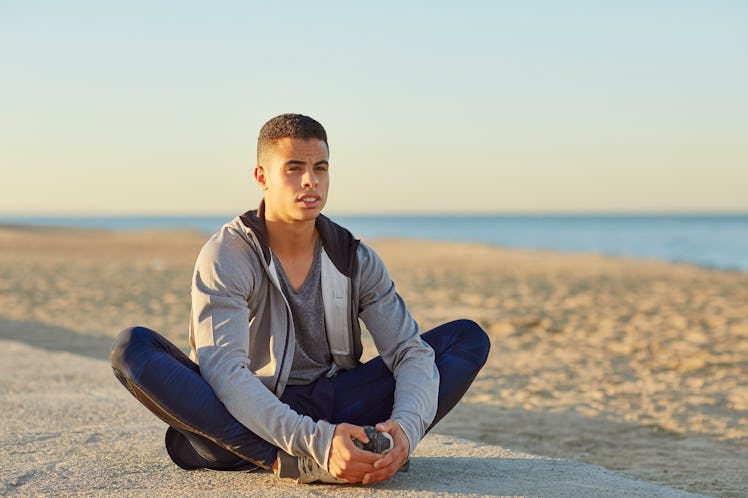10 Hip-Opening Stretches To Prevent Injury And Ease Pain
Tight hips can afflict both athletes and couch potatoes alike, and lead to tons of pain and injury. Try these moves to get them loose.

Tight hips are to blame for so much pain, lack of gain, and injury. When it comes to movement, so much rides on the hips. Tight hips — which can be a symptom of both sitting all day and running, lifting, or moving without stretching — can lead to wear and tear on the knees, ankles, and even the heels. Hip-opening stretches not only help loosen those hips, but they can help prevent future injury to the rest of your body — from knee pain to plantar fasciitis. The trouble is that hip-opener stretches are not exactly intuitive. If you have tight hamstrings, you touch your toes. Tight quads? Pick up your foot. But to get into your tight hip flexors, you’re going to have to work for it.
These 10 hip-opening stretches will loosen up those hard to reach hip flexors. Just ease into each position, stretch until you can feel it, and don’t overdo it. A good stretch generally lasts 10-60 seconds, but you should always stop if you feel pain.
Cobbler Pose
Sitting down, bring the soles of your feet together so that your knees splay out to the side. (If you have a child enrolled in ballet, they’ll be familiar with this pose, otherwise known as a butterfly.) Bend forward from the hips. You’ll get a deeper stretch moving only slightly forward with a flat back than you will if you touch your head to your toes with a curved spine.
Forward Bend
Touching your toes is simple, but if you do it with proper form, it provides a more far-reaching stretch than you might imagine. They key is to keep your back flat as you lower yourself down to really activate the hips and hamstrings.
Crescent Lunge
From standing, drop a knee, placing a pillow, blanket, or folded yoga mat under it to avoid discomfort. Push your hips forward, (your upright knee will start to shift towards your toes) arch your back, and lift your arms overhead. Hold for one minute (it will feel much longer) and switch sides.
Child’s Pose
Everyone’s favorite yoga pose is a great not-too-strenuous hip opener. Sitting back on your heels, open your knees a little wider than hip distance apart. Place your hands on the floor and slide them forward until your head is touching the floor.
Cat-Cow
On all fours, draw your belly in and up and arch your back, rounding your head down. Then arch your back the other way, pushing your belly down towards the ground and lifting your head up to the sky. Repeat for several breaths.
Pigeon Pose
From all fours, bring your right knee forward to your right wrist. Turn your right hip out, bringing your right foot to your left wrist. Lower your right leg and hips to the floor so that your left leg is straight. This will likely feel strenuous enough, but if you want a deeper stretch, you can bend at the hip and lower your head to the matt. Switch sides and repeat.
Frog Stretch
Laying on your stomach, bring the soles of your feet together, drawing them upwards toward your back so that your knees splay outwards. This is like the inverse of the butterfly stretch.
Figure 4
Standing and holding onto something, take your right foot and cross it over your left knee, so that you resemble a 4. Sit back like you’re about to sit in a chair. Do on both sides.
Sitting Figure 4
Laying on your back bring both knees to your chest. Take your right foot and cross it over your left knee. Clasp your hands behind your left knee and pull it in to your chest. Repeat on the left side.
Twisted Lunge
Take a big step forward with your right leg, bending it until you can touch the ground, keeping your left leg straight. Twist to your right, lifting your right arm to the sky and looking up. Switch legs so that your left leg is bent and in front of you and your right leg is extended back like a plank. Twist to your left, lifting your left arm and looking up.
This article was originally published on